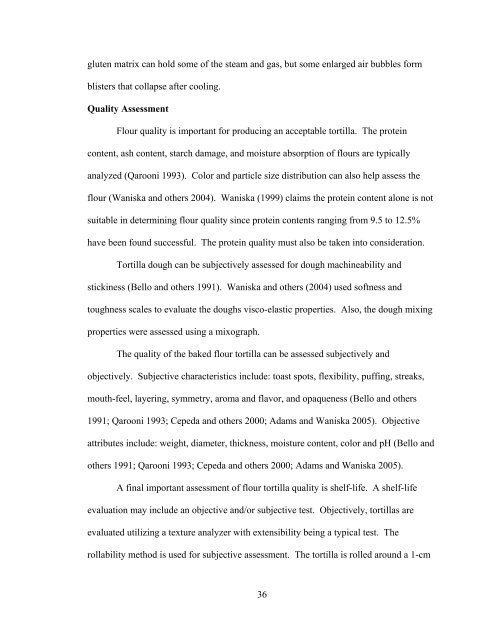EVALUATION OF FOUR SORGHUM HYBRIDS THROUGH THE ...
EVALUATION OF FOUR SORGHUM HYBRIDS THROUGH THE ...
EVALUATION OF FOUR SORGHUM HYBRIDS THROUGH THE ...
You also want an ePaper? Increase the reach of your titles
YUMPU automatically turns print PDFs into web optimized ePapers that Google loves.
gluten matrix can hold some of the steam and gas, but some enlarged air bubbles form<br />
blisters that collapse after cooling.<br />
Quality Assessment<br />
Flour quality is important for producing an acceptable tortilla. The protein<br />
content, ash content, starch damage, and moisture absorption of flours are typically<br />
analyzed (Qarooni 1993). Color and particle size distribution can also help assess the<br />
flour (Waniska and others 2004). Waniska (1999) claims the protein content alone is not<br />
suitable in determining flour quality since protein contents ranging from 9.5 to 12.5%<br />
have been found successful. The protein quality must also be taken into consideration.<br />
Tortilla dough can be subjectively assessed for dough machineability and<br />
stickiness (Bello and others 1991). Waniska and others (2004) used softness and<br />
toughness scales to evaluate the doughs visco-elastic properties. Also, the dough mixing<br />
properties were assessed using a mixograph.<br />
The quality of the baked flour tortilla can be assessed subjectively and<br />
objectively. Subjective characteristics include: toast spots, flexibility, puffing, streaks,<br />
mouth-feel, layering, symmetry, aroma and flavor, and opaqueness (Bello and others<br />
1991; Qarooni 1993; Cepeda and others 2000; Adams and Waniska 2005). Objective<br />
attributes include: weight, diameter, thickness, moisture content, color and pH (Bello and<br />
others 1991; Qarooni 1993; Cepeda and others 2000; Adams and Waniska 2005).<br />
A final important assessment of flour tortilla quality is shelf-life. A shelf-life<br />
evaluation may include an objective and/or subjective test. Objectively, tortillas are<br />
evaluated utilizing a texture analyzer with extensibility being a typical test. The<br />
rollability method is used for subjective assessment. The tortilla is rolled around a 1-cm<br />
36

















